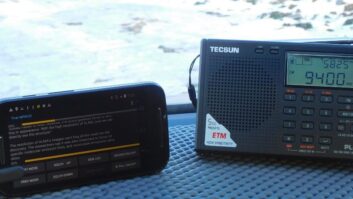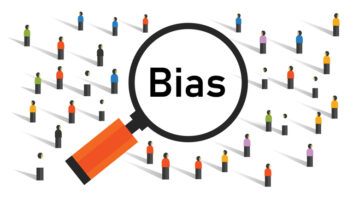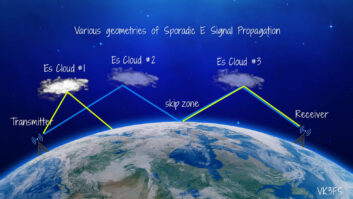MORE PSA SUGGESTIONS
I agree with much that the author, Dan Slentz, states in his article “Underwriting and PSA Tips for Noncoms” (RW April 25). However, I take exception to a few of his points.

When “building your brand,” you must be careful to not promote your business or product since “No promotional announcement on behalf of for profit entities shall be broadcast at any time” (from 47C.F.R. §73.503(d)). It also states, “However, acknowledgements of contributions can be made.” This does not prohibit an NCE station from running commercials and promoting bona fide 501(c)3 nonprofit entities and for the station itself.
But watch out for prohibited complications involving commercial entities when tickets become involved.
The underwriting rule is for acknowledging contributions, and the FCC therefore allows identification of the donor, but there can be no promotional content. Broadcasters have figured out that the FCC will ding you for calls to action, pricing, comparatives and qualitative statements. Those prohibitions are not specified in the rules but are particular ways the FCC specified as reasons it fined stations for not adhering to the rule prohibiting any promotional announcements for commercial entities. Those are not necessarily the only ways to get into trouble for promoting a commercial entity.
The FCC rules do not have a rule exemption for slogans, so there is nothing allowing promotional or otherwise prohibited wordings when used within a slogan. About 15 years ago, I was on a conference call with a number of NCE stations addressing this very issue. Someone used the example that you could say, “You are in our hands with ‘MyState’ Insurance” but that “good” could not be used in the popular slogan in an underwriting announcement because it is a comparative word that represents the company. It does not matter whether or not it is in a slogan.
The author correctly stated that “If it feels, smells, looks, tastes or sounds like a commercial, it probably is a commercial!” But I would take that statement farther to say, “If it sounds promotional, then it is not allowed.” Permissible underwriting statements usually have passive verbs and do not include adjectives or adverbs.
Also, an underwriting announcement should be short. The FCC in DA-18-74 (a ruling dated Feb. 1) against two NCE stations said underwriting announcements 30 to 90 seconds in length were too long.
In paragraph three, the FCC states: “While an NCE licensee may broadcast underwriting announcements identifying entities that donate to the station by name, such announcements may not promote an entity’s businesses, products, or services. In addition, such announcements may not contain comparative or qualitative descriptions; price information (sales or discounts); calls to action; inducements to buy, sell, rent, or lease; and excessively detailed ‘menu listings’ of services offered by the entity. While the commission has not adopted any quantitative guidelines on underwriting announcements, it has found that the longer the announcement, the more likely it is to contain material that is inconsistent with their ‘identification only’ purpose. At the same time, however, the commission has acknowledged that it is at times difficult to distinguish between language that promotes versus that which merely identifies the underwriter. Consequently, the commission expects that licensees exercise reasonable ‘good faith’ judgment in this area and affords some latitude to the judgments of licensees who do so.”
I recall reading (I cannot put my hand on the reference right now) that there can be situations when providing contact and location information for the donor’s business would be appropriate — if it were not common knowledge, easily obtainable or if the business might be easily confused with other businesses. It communicated the expectation that this would not be common for most underwriting announcements.
Sometimes, when we see a forest we can forget to look at the trees. After all, “promotion” is the term used in the rule for what is prohibited in underwriting statements. Let’s get back to basics for compliance. We must stick to what is permitted: Identify the donor whose donation we acknowledge! Then it is a lot easier to avoid what is not allowed — anything promotional.
Alan Kilgore, WB4THU
Chief Engineer, WRVM(FM)
Suring, Wis.
ANOTHER RADIO RASCAL

Responding to “The Rabble-Rousers of Early Radio Broadcasting,” RW Sept. 1:
Very good article; well-researched. The one rascal not mentioned, however, is the Rev. Carl McIntire, who lost his FM radio license in Media, Pa., in 1973-74. He then proceeded to run a pirate AM station off the coast of New Jersey for a few months.
McIntire’s one-side right wing broadcasts were curtailed because he did not provide opposing views required under The Fairness Doctrine. (In 1987, Ronald Reagan eliminated the Fairness Doctrine, paving the way for Rush Limbaugh.)
Thanks for the great information!
Pete Simon
Arvada, Colo.
UNDERSTANDING PIRACY’S ROOTS
David Honig’s excellent article “What Will Take Down Radio Pirates — And What Won’t” (RW Sept. 26) hit the nail squarely on the head, particularly with regard to his opinion that minority communities are under-served by mainline radio stations.
While not excusing radio piracy, it does help to explain it. And while illegal interference to licensed stations is unacceptable, I suspect in many cases licensees so challenged object to interlopers in their exclusive game preserves, same as established restaurants harass the hotdog vendor on the corner. I applaud Multicultural Media, et. al. for highlighting and championing minority representation on the radio dial, albeit not through piracy.
Licensed stations need to awaken to this market and serve it with its music, news, entertainment and sponsors to diminish the appeal of radio piracy to those underserved communities.
But Honig’s best quote is: “First, [Congress] needs to restore the cuts to the FCC’s budget that brought about the closure of critical field offices.” Hallelujah and amen! That astounding action was akin to closing half the hospitals in the country in the midst of a crippling epidemic. Unfortunately, many highly qualified FCC engineers were cast aside in favor of lawyers who lack grassroots experience with radio communications engineering. Yes, by all means: Ramp-up those shuttered field offices and give the radio cops the tools necessary to patrol the airwaves again!
James B. Potter
Owner/CEO
Cutting Edge Engineering, The Little Spot Shop and JBPotter Agency
Kimberling City, Mo.
ALLOCATIONS AND THE C4 PROPOSAL

Responding to “What Is the Real Problem With the Proposed FM Class C4?” (www.radioworld.com, keyword “Haynes”):
I find this commentary more than a little disingenuous. The author seems to imply that he is somehow losing coverage over his primary broadcast area because he can’t have 12 kW.
A cursory check of WRTM shows that unlike the implication in the commentary, it’s not a signal licensed to Jackson, Miss. It is licensed to a suburb well outside the city (Sharon, Miss.), and clearly it has been shoehorned in as close as possible to the larger Jackson metro using a highly directional antenna that barely covers its community of license.
In other words, instead of working within the established schema for Class A FMs to be local broadcast services — not regional — WRTM has attempted to finagle its way into audience it’s not supposed to have, and now is demanding that the FCC give it even more coverage that it’s not supposed to have.
If you want to argue that the FCC’s system of allocations is a poor fit for the modern radio usage landscape? Fine, I’m 100 percent in agreement with that. But don’t pretend that you’re somehow magically being deprived of something and doubling your power — no doubt at the expense of both other nearby stations and the overall health/noise floor of the band — is going to solve all your problems.
We’ve been here before when all the Class C AM stations were increased to 1 kW day/night, and look what happened: It just made the mess worse.
If WRTM isn’t financially viable for you now, then it should be allowed to go under and re-auctioned to someone else. And if no one claims it, so much the better, as it cleans up the band just that much more.
Aaron Read
Director of Information Technology & Engineering
Rhode Island Public Radio
Providence, R.I.
FINDING AND TRAINING ENGINEERS
A recent Radio World email blast included a link to a piece titled “Help! I Have to Train an Engineer!” (from 2006). I found it somewhat amusing. Until I didn’t.
We have a problem finding and training broadcast engineers. It is a demanding career on many levels.
You need to understand audio, RF, computer networking and even computers. You will have to solder and crimp, and you may be asked to perform board level troubleshooting and repair.
This is a skill set that is not taught in most four-year degree programs. More specialized schools will do a better job, but they are not found in every community.
The article listed quite a few programs, but I wanted to make sure folks know about the training provided by Synergetic Audio Concepts (aka Syn-Aud-Con) and, more recently, Pro Audio Training (www.proaudiotraining.com).
In the way-too-many years that I’ve been attending seminars and training programs, this is the one that stands out. Their training is geared toward systems that terminate at a loudspeaker instead of a transmitter, but they cover the fundamentals so well that I recommend them to anyone interested in audio.
Syn-Aud-Con has been at the forefront of audio training since the early 1970s. They are the ones that brought pressure zone microphones, TEF and LEDE to the attention of the audio community at large. Which is kind of cool when you think about it.
But their biggest strength (to me at least) is their coverage of the fundamentals, the math and physics behind sound in the air and in a copper wire (including Ethernet/IP). Students can’t help but understand how the decibel and Ohm’s Law work and what the terms mean.
They offer both online and in-person training, and I think it is invaluable! I happily recommend it to anyone who asks.
Bill Thompson
CARRIER CURRENT

Interesting article on “The End of Carrier Current?” by Dan Braverman from October 2017.
There are several hobbyists still out there doing it. I’ve been doing this mode of broadcasting since early 1991, and I find it interesting that, when you see Carrier-Current gear come up on eBay, it sells out almost immediately. So somebody must still want this mode of broadcasting out there.
It is true that in the Part 15 license-free broadcasting circles, the 10 foot antenna to a 100 mW PEP AM transmitter is way more popular. With most folks, the idea of Carrier Current, in which you couple to the power lines, seems to scare people off of trying it. Given that, the majority of hobbyists out there are broadcast engineers of whom know what they are getting into. Nonetheless, it is another permissible broadcasting method that’s license-free, and maybe still an LPAM option for those who can’t do LPFM, for whatever reason.
Besides broadcast, Carrier-Current operations still exist in places where people don’t realize. Those wired-wireless FM intercoms? They use a low frequency of around 170 kHz and couple about 10 milliwatts to your house wiring in order to communicate within your home. Mining companies use it as a means to couple communications to what already exists for them. Power lines that have been installed down through mining shafts. Power companies still use carrier-current techniques for power station switching and monitoring.
Anyway, Carrier-Current techniques still exist, but with both LPB Inc., and Radio Systems, gone, this is indeed a blow to this method of broadcasting.
Phil Schoenthal
Owner/operator, AM610 / AM1620
Poca, W.Va.





